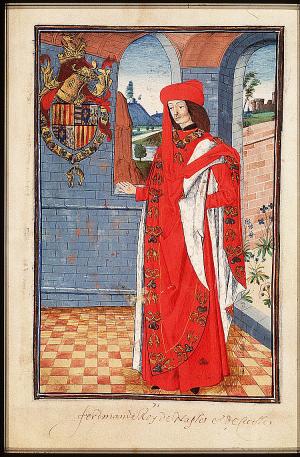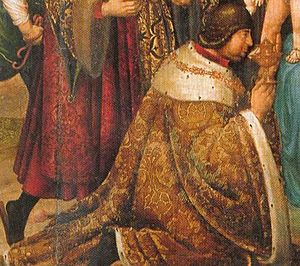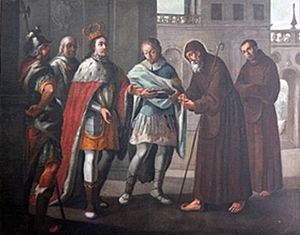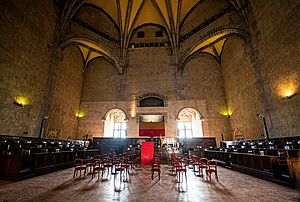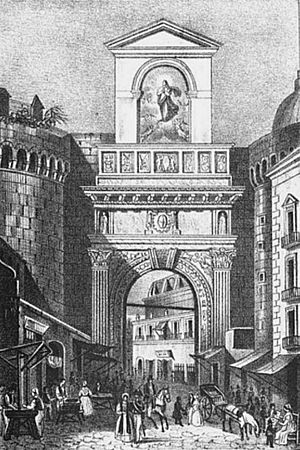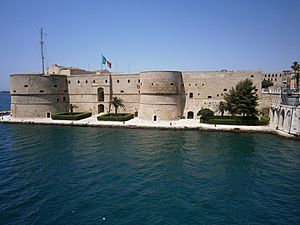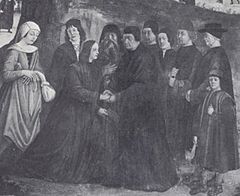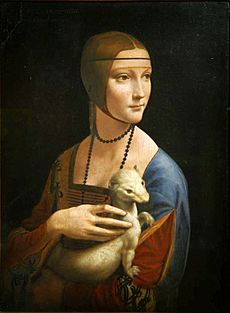Ferdinand I of Naples facts for kids
Quick facts for kids Ferdinand I |
|
|---|---|

Contemporary bust of Ferdinand
|
|
| King of Naples | |
| Reign | 27 June 1458 – 25 January 1494 |
| Coronation | 16 August 1458 Barletta Cathedral, Apulia |
| Predecessor | Alfonso I |
| Successor | Alfonso II |
| Born | 2 June 1423 Kingdom of Aragon |
| Died | 25 January 1494 (aged 70) Naples, Kingdom of Naples |
| Burial | San Domenico Maggiore, Naples |
| Spouse | Isabella of Clermont Joanna of Aragon |
| Issue among others... |
Alfonso II, King of Naples Eleanor, Duchess of Bari and Ferrara Frederick I, King of Naples Cardinal John Beatrice, Queen of Hungary and Bohemia Joanna, Queen of Naples Ferdinand, Duke of Montalto |
| House | Trastámara |
| Father | Alfonso V of Aragon |
| Mother | Giraldona Carlino |
| Religion | Roman Catholicism |
Ferdinand I, also known as Ferrante, was the King of Naples from 1458 to 1494. He was born on June 2, 1424, in Valencia. Ferrante was the only son of Alfonso I of Naples, though he was born outside of marriage.
Ferrante was a very important and powerful ruler in Europe during his time. He played a big role in the Italian Renaissance. During his 30 years as king, he brought peace and wealth to Naples. He was known for his smart foreign relations and alliances. He earned the nickname Judge of Italy because he helped keep peace among the different Italian states. He also supported artists and thinkers.
He introduced new laws that helped regular people like artisans and farmers. These laws reduced the power of the wealthy noble families, called Barons. This led to a famous revolt known as the Conspiracy of the Barons, which Ferrante eventually stopped.
Ferrante had to prove himself many times to keep his throne. He was a strong leader and a skilled military commander. His kingdom was often attacked by powerful groups like the Ottoman Empire, France, Venice, and the Papal States. He spent much of his life in wars.
He was known for his courage and political skills. He loved Italian culture and surrounded himself with artists and humanists. He finished many building projects in Naples that his father started. He also built new, impressive structures that you can still see today.
Ferrante's clever diplomacy helped Naples become a leading state in Italy. He brought new ideas like silk production and printing to the kingdom. He also promoted culture and learning. Under his rule, the Kingdom of Naples had the strongest navy in the western Mediterranean.
Contents
Biography
Becoming King
Early Life and Education
Ferrante's mother was Gueraldona Carlino, likely from Naples. His father, King Alfonso, brought him to Naples to prepare him for leadership. In 1438, young Ferrante sailed from Barcelona to Italy. He met his father, whom he barely knew.
They quickly formed a strong bond. Alfonso saw Ferrante's intelligence and bravery. Ferrante greatly respected his father. In 1438, Alfonso made Ferrante a knight.
In Naples, Ferrante had excellent teachers who taught him for many years. He also studied law. He was later made president of the kingdom's main judicial court.
In 1439, Ferrante became the lieutenant general of the kingdom. His father, King Alfonso, officially declared him his heir in 1440. In 1441, the barons of the kingdom also approved Ferrante as the future king. They gave him the title of Duke of Calabria, which was usually for the king's first son.
On March 3, 1443, King Alfonso publicly gave Ferrante a sword and a flag. He placed a ducal crown on his head. Everyone was told to call him Duke of Calabria.
The Pope also recognized Ferrante's right to the throne. This was confirmed by two different Popes. In 1444, Ferrante married Isabella of Taranto. She was the heir to a powerful principality, which strengthened Ferrante's position.
War Against Florence
In 1452, King Alfonso ordered Ferrante to lead an army against the Florentines. This was to help the Venetians. Ferrante marched his army into Abruzzo.
However, a terrible plague spread through Ferrante's army. Many soldiers and leaders became sick. The war in Tuscany ended when winter came.
Alfonso later made peace with Venice and Siena. Ferrante was ordered to return to Naples. He entered the city on August 28, 1454, and was welcomed with great joy.
In 1455, a cardinal came to Naples to arrange a general alliance of Italian states. Alfonso, on behalf of himself and Ferrante, signed a peace and friendship agreement with the Duke of Milan and the Florentines.
Becoming King: A Difficult Start
Ferrante became King of Naples in 1458, when he was 35. He immediately faced many challenges. Some people wanted Charles, Prince of Viana to be king. The barons wanted King John II of Aragon to take over. And the Pope wanted the kingdom for the Holy See. Ferrante had to fight all these powerful enemies.
Charles, Prince of Viana, argued that Ferrante could not be king because he was born outside of marriage. Charles tried to get support in Naples. But the people and many barons remembered their promise to Alfonso. They shouted, "Long live King Ferrante, our true King!" Charles then fled to Sicily.
Ferrante still needed the Pope's approval. He sent ambassadors to Rome to ask for the Pope's blessing. But Pope Callixtus III was not on his side.
Ferrante decided to go ahead with his coronation. He rode to the city cathedral with the barons. The Archbishop of Naples blessed him and declared him King. The people cheered loudly. Ferrante then rode through the city, showing his new authority.
However, Pope Callixtus III was against Ferrante. He declared that the throne of Naples was empty. He claimed Ferrante was not Alfonso's true son. The Pope wanted to give the crown to his own nephew. He ordered everyone not to obey Ferrante.
Ferrante called a meeting of the barons and people. They all swore loyalty to him. Ferrante also wrote a strong letter to the Pope. He stated that he was the rightful king, recognized by his father and previous Popes. Ferrante had an alliance with the Duke of Milan, which helped him.
Pope Callixtus III died in August 1458, without achieving his goal. Ferrante was relieved. He quickly sent new ambassadors to the next Pope, Pope Pius II. Pope Pius II agreed to recognize Ferrante as king, but with conditions. Ferrante had to pay back taxes and help the Pope when needed. He also had to return some lands to the Church.
Ferrante was officially crowned on February 4, 1459, in the Cathedral of Barletta. To thank the Pope, Ferrante arranged for his daughter Maria to marry the Pope's nephew. He gave them a rich dowry. But his problems were not over. John of Anjou still wanted the throne of Naples.
The Angevin-Aragonese War (1460-1464)
Some powerful barons, like the Prince of Taranto, wanted to weaken Ferrante. They tried to get King John of Aragon to conquer Naples, but he refused. Then they invited John of Anjou, son of René, to claim the throne. John of Anjou sailed to Naples in 1459.
Many barons and cities joined John of Anjou. Ferrante's wife, Queen Isabella, helped defend Naples while her husband was away.
A major event was the Torricella meeting in 1460. Marino Marzano, a baron who hated Ferrante, tried to trick the king. He arranged a meeting near Teano, pretending to want peace. But it was a trap. Ferrante bravely fought off two attackers alone. He even discovered one of their daggers was poisoned. This event was later shown on the bronze door of Castel Nuovo.
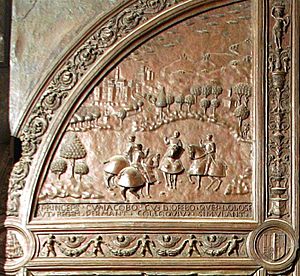
Ferrante was first defeated by John of Anjou in the Battle of Sarno in 1460. He was saved by troops from Cava de' Tirreni, who surprised the enemy. This battle was not decisive. Ferrante received more help from the Duke of Milan.
Ferrante's Comeback
The Duke of Milan sent his brother and nephew to help Ferrante. They helped convince some rebel barons to return to Ferrante's side. The Prince of Salerno, a very important baron, switched his loyalty. Many other barons followed his example. This changed the war in Ferrante's favor.
Pope Pius II also sent troops to help Ferrante. The Duke of Milan sent more aid. Ferrante began to win back lands in Abruzzo and Apulia. Many cities surrendered to him.
A great help came from Gjergj Kastrioti, a famous leader from Albania. He arrived with many ships and experienced soldiers. Skanderbeg was known for fighting the Turks. He came to help Ferrante because Alfonso the Magnanimous had helped him years before.
Ferrante welcomed Skanderbeg warmly. Skanderbeg's arrival made Ferrante's enemies nervous. In a major battle, Skanderbeg and Ferrante's army defeated their enemies. Four thousand enemies were killed, and a thousand were captured. Ferrante returned to Naples as a hero.
Only the island of Ischia remained under Angevin control. In 1464, John of Anjou, seeing he was isolated, left for Provence. Ferrante had won.
Years of Peace and Growth
Royal Marriages and Family Life
After defeating his enemies, Ferrante focused on rebuilding his kingdom. He also used marriages to secure alliances. His eldest son, Alfonso, married the daughter of the Duke of Milan. His eldest daughter, Eleanor, married the Duke of Ferrara. His younger daughter, Beatrice, married the King of Hungary.
Sadly, his first wife, Queen Isabella, died. She was greatly loved and missed. Years later, in 1477, King Ferrante married his cousin Joanna.
Improving the Kingdom
The end of the barons' rebellion brought 20 years of peace. This allowed Ferrante to make his kingdom stronger and richer. He took lands from the rebel barons, which shifted power towards the crown. Ferrante did not trust the barons.
He introduced new laws to help ordinary people. In 1466, he allowed farmers to sell their products freely, without being forced to sell to local lords at low prices. This gave farmers more freedom.
Cities owned by the state became more important. Ferrante controlled the power of the nobles. He protected Jewish communities, who were active in trade and crafts. He also supported the growth of city leaders to balance the power of the feudal nobles.
Ferrante also worked to restart industries like silk and wool production. He even became involved in business himself.
He greatly promoted arts and culture. He supported the University of Naples. During his reign, Italian and Latin culture flourished. Important writers and thinkers lived in Naples. The kingdom became a major center for Humanism and the Renaissance.
Ferrante also formed alliances with other Italian states like Florence and Milan. This helped keep peace in Italy. However, these alliances were often fragile.
Printing Press and Saint Francis
In 1470, Ferrante was one of the first rulers to bring the printing press to Italy. He hired skilled printers and paid them well. Many important books were printed in Naples, including classic Latin works and books on law and medicine.
Ferrante also met Saint Francis of Paola, a very holy monk. The King of France had asked Saint Francis to visit. Ferrante welcomed him to his palace in Naples in 1481. Ferrante asked the saint to build a monastery in Naples. Saint Francis chose a rocky spot overlooking the sea.
The story goes that Ferrante offered Saint Francis a tray of gold coins for the monastery. Saint Francis refused. He took a coin, broke it, and blood came out. He said the blood was from the suffering people, showing that the coins were gained by oppressing them. This showed Ferrante the importance of treating his people fairly.
Later Years and Challenges
The Pazzi Conspiracy (1478-1480)

In 1478, Ferrante got involved in the Pazzi conspiracy in Florence. He sided against Lorenzo de' Medici. Ferrante made a secret deal with the Turkish sultan. The sultan attacked Venice, which stopped Venice from helping Florence.
Ferrante's son, Alfonso, led the Neapolitan army in Tuscany. The Florentines had to make peace. Lorenzo de' Medici himself traveled to Naples to meet Ferrante. This was a very important meeting.
The peace treaty was signed in March 1480. It created an alliance between Florence and Naples. This alliance was very good for Ferrante. It helped protect his kingdom from enemies inside and outside. Lorenzo de' Medici became a trusted ally of Ferrante.
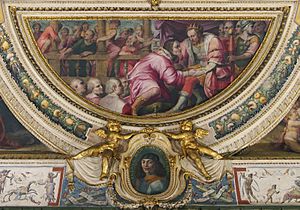
War of Otranto (1480-1481)
In 1480, while Ferrante was making peace with Florence, the Turks attacked his kingdom. A large Turkish fleet appeared near Otranto. The city was defended by only a thousand fighters. The citizens fought bravely, but the powerful Ottoman army captured Otranto. Most of the people were killed.
Eight hundred citizens of Otranto were asked to give up their Catholic faith and become Muslims. They bravely refused and were killed. They are remembered as the Martyrs of Otranto.
Ferrante was very worried. He asked for help from all over Europe. He called his son Alfonso back from Tuscany. Ferrante also ordered the building of new forts, like the Ferrante tower in Brindisi.
Alfonso gathered an army and a fleet. The King of Hungary and the Pope also sent soldiers and ships. The Pope even forgave the Florentines for their past actions to unite Italy against the Turks.
After many battles, the Turks were forced to retreat into Otranto. The death of the Ottoman Sultan, Mehmed II, caused problems among his sons. This made the Turkish commander in Otranto realize he would not get help. He surrendered to Alfonso.
Alfonso returned to Naples as a hero. The people cheered him. The bones of the brave Martyrs of Otranto were buried with honors. Ferrante was praised as the savior of Italy and Europe.
War of Ferrara (1482-1484)
In 1482, Venice and the Pope allied against the Duke of Ferrara, who was Ferrante's son-in-law. Ferrante was tired from the war in Otranto. But he decided to help his son-in-law to prevent Venice and the Pope from becoming too powerful. Florence and Milan also joined Ferrante to help Ferrara.
Ferrante's son, Alfonso, led the army. He attacked the Pope's lands and even besieged Rome. However, Alfonso's army was defeated in a battle called Campomorto. Alfonso barely escaped.
The Pope then made peace with Ferrante. He allowed Alfonso's army to pass through his lands to defend Ferrara. Meanwhile, the Venetians continued the war. They even invited a French duke to claim the throne of Naples.
Pope Sixtus IV, at Ferrante's request, officially banned the Venetians from the Church. Ferrante sent his son Frederick to attack Venetian lands by sea. The Venetians captured some cities in southern Italy. Ferrante, fearing more damage, asked for peace. A peace treaty was signed in 1484.
Second Barons' Conspiracy (1485-1486)
King Ferrante, being older, gave much control to his son Alfonso. Alfonso did not like the barons and often threatened them. He wanted to reduce their power. This, combined with Ferrante's desire for a stronger central government, made the barons very angry.
In 1485, the barons started a second revolt. They were led by powerful figures like the Prince of Salerno. They asked Pope Innocent VIII for help, and the Pope agreed. The Pope even encouraged the King of France to invade Naples.
Alfonso discovered the plot and quickly captured some of the conspirators' lands. The other barons openly rebelled. The kingdom became very chaotic.
Ferrante tried to make peace. His son Frederick, who was kind and well-liked, went to Salerno to negotiate with the barons. The barons tried to convince Frederick to take the throne instead of his brother Alfonso. But Frederick refused, saying he would not betray his father or brother. The barons then imprisoned Frederick.
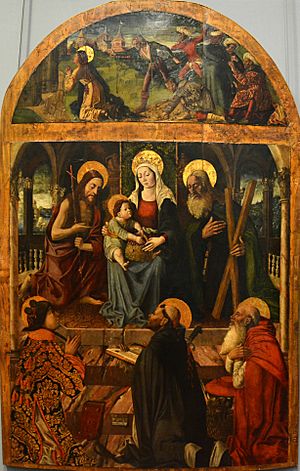
Ferrante was furious. He sent Alfonso's army to attack the Papal States. He also ordered all clergy in Rome to return to Naples. Those who refused lost their income.
Pope Innocent VIII, seeing no help from France or Venice, finally agreed to a peace treaty. The barons also accepted. The agreement was signed in August 1486. It stated that Ferrante would recognize the Church's authority and pay taxes. He also promised to stop bothering the barons.
The Duke of Milan, the King of Spain, and Lorenzo de' Medici helped sign this agreement. Pope Innocent VIII then became a close friend of Ferrante. In 1492, the Pope confirmed that Alfonso would be Ferrante's successor.
Ferrante's Revenge on the Barons
Despite the peace treaty, the barons were still worried about Alfonso's cruelty and Ferrante's dishonesty. Many barons fortified their castles. The Prince of Salerno secretly fled to Rome and then to France.
Ferrante and Alfonso wanted revenge on the main conspirators. They chose a wedding celebration at Castel Nuovo as the moment. Ferrante imprisoned Francesco Coppola and Antonello Petrucci, two key leaders of the conspiracy. They were later executed. Their wealth was taken by the state.
After this, Ferrante imprisoned many more barons. Most of them were secretly killed. To make people believe they were still alive, the king sent them food for a long time. But rumors spread when an executioner was seen with a gold chain belonging to one of the princes. It was believed the barons were killed, put in sacks, and thrown into the sea.
The Aftermath
Other rulers were angry that Ferrante had broken his promise of forgiveness. Alfonso and Ferrante tried to defend their actions, but it was difficult. The Pope encouraged King Charles VIII of France to invade Naples. Ferrante managed to avoid this threat with a new treaty.
During this time, the kingdom faced a severe food shortage. People were dying of hunger. Ferrante worked hard to help his people. The grateful Neapolitans made special coins in his honor.
King Ferdinand the Catholic of Spain also complained about Ferrante breaking the peace. Ferrante sent an ambassador to apologize. There were talks of a marriage between Ferrante's grandson and one of Ferdinand the Catholic's daughters, but it didn't happen.
Final Years
Ferrante continued to rule actively. He was respected for his customs. After gaining wealth from the barons' downfall, he used it to strengthen the kingdom. He hired famous military leaders and fortified the capital's castles.
He also promoted education. He ordered his subjects to support sciences in Naples. He allowed only Naples and L'Aquila to have universities.
In 1492, Lorenzo de' Medici and Pope Innocent VIII died. The new Pope was Pope Alexander VI. The new leader of Florence, Piero de' Medici, remained Ferrante's ally.
In 1493, King Charles VIII of France began preparing to invade Italy to conquer Naples. Ferrante realized this was his biggest challenge yet. He warned other Italian rulers about the danger. But his talks with the Pope and the Duke of Milan failed. Ferrante died before he could secure peace for his kingdom.
The End of the Reign
King Ferrante, who had kept peace in Naples and Italy, began preparing for war against France. But he fell ill with a fever and died on January 25, 1494. He was more affected by sadness than by old age. He was a strong and clear-minded man until the end.
Just before he died, he blessed his children and grandchildren. He then prayed, "God, forgive my sins," and passed away. Later studies of his preserved body showed he likely died of cancer. His death was preceded by large earthquakes in Naples and other cities.
Ferrante's funeral was grand. His body was preserved and placed in a golden chest. He was buried in the Basilica of San Domenico Maggiore in Naples. His death was a great loss for his family and the kingdom.
His son, Alfonso II of Naples, became king. But Alfonso soon gave up the throne to his own son, Ferrandino. This was because of the feared invasion by Charles VIII of France in 1494.
The change in kings did not help. The Aragonese family's power was weakening. Many nobles in Naples sided with the French king, which led to the fall of the royal family.
Appearance and Personality
King Ferrante was of medium height with brown hair and a dark complexion. He was very strong. There's a story that he once stopped an angry bull by grabbing its horn.
He was graceful in conversation, clever, and patient. He was quick to make decisions and good at hiding his true feelings. He had great courage and political skill. He enjoyed jesters and hunting, especially with falcons. He was polite and generous. For example, he once gave 300 horses to a friend.
Ferrante was very educated and knew a lot about law. He believed law was essential for rulers. He loved writers and poets. It is said he sometimes forgave serious criminals at their request. He strongly supported sciences and literature, giving money and help to scholars. His library was one of the most famous of his time. He even wrote a book of letters and prayers.
While he was generous to those loyal to him, he was also very strict and cruel to his enemies. He often used tricks and false promises to capture them.
He loved his family very much, especially his first wife, Isabella, and his daughters. He enjoyed being around children. He took care of orphans and relatives at his court.
Ferrante also loved music. He brought talented singers and organ builders to his court. He was even said to be a skilled musician himself. He founded the first music school in Italy.
Like his father, Ferrante was a man of great faith. He attended mass on his knees and washed the feet of the poor. He was modest in his eating habits and appearance. However, he loved grand ceremonies and magnificent clothing.
He was fascinated by knightly orders. He founded the Order of the Ermine, with the motto "Malo mori quam foedari" (I prefer to die rather than be dishonored). He also received honors from other orders, like the Golden Fleece. He enjoyed tournaments and horseback riding, which helped him stay strong.
Ferrante's Naples
Ferrante helped create the beginnings of a modern state. He set up new government bodies and strengthened financial systems.
His skills and diplomacy helped Naples become a powerful state in Italy. He introduced silk production and printing. He also promoted culture and attracted intellectuals. This made the Kingdom of Naples a major center of Humanism and the Renaissance.
He expanded the walls of Naples, especially on the eastern side, starting in 1484. These new walls were designed to withstand cannon fire. They were very strong, with thick sections and powerful towers.
Under his rule, the Castel Nuovo was completed. He also ordered the building of beautiful palaces like Palazzo Como and Porta Capuana. Porta Capuana is considered one of the most beautiful Renaissance gates.
Ferrante reformed the University of Naples. He reopened it in 1465 with many teachers. He encouraged the study of Greek and Latin. He even made it mandatory for his subjects to study in the kingdom. He invited famous scholars to teach.
He was a great supporter of Renaissance culture and art. He surrounded himself with many artists and writers. The famous Academy of Naples, one of the first in Europe, flourished under his patronage.
He ordered the creation of the splendid bronze door of the Castel Nuovo. This door showed scenes of his triumph over the barons' conspiracy.
Ferrante also oversaw the reconstruction of the Naples Cathedral after an earthquake in 1456. He encouraged noble families to help rebuild it. He also had the Basilica of San Domenico Maggiore rebuilt.
In 1486, Ferrante hired an architect to expand the fortress of Taranto. He wanted to update it for cannons. The new Aragonese castle of Taranto was completed in 1492.
His royal library grew greatly with new purchases and gifts. He encouraged the use of the Neapolitan language in poetry. He also supported popular literature.
Ferrante loved music. He brought skilled musicians from Burgundy to his court. He established the first music school in Italy. This school was very important for the development of Neapolitan music.
To strengthen the kingdom's finances, Ferrante introduced strict spending rules. He encouraged trade with Venice, Pisa, and Spain. He also allowed many Jewish refugees from Spain to settle in Naples. The population of Naples grew quickly, requiring the city walls to be expanded.
He also granted some cities, like Brindisi and Capua, the right to mint their own coins. He encouraged new industries like silk and wool weaving.
Museum of Mummies
Ferdinand had a unique way of dealing with his enemies. After they were killed, he had their bodies preserved. He kept them in a private 'black museum'. The bodies were dressed in the clothes they wore when alive. If he suspected someone was plotting against him, he would take them to visit this 'museum' as a warning.
Marriages and Children
From his first wife, Isabella of Clermont, he had six children:
- Alfonso II (1448–1495), who became King of Naples.
- Eleanor (1450–1493), who married the Duke of Ferrara.
- Frederick I (1451–1504), who also became King of Naples.
- Giovanni (1456–1485), a cardinal.
- Beatrice (1457–1508), who became Queen of Hungary and Bohemia.
- Francesco (1461–1486), Duke of Sant'Angelo.
From his second wife, Joanna of Aragon, he had one daughter:
- Giovanna (1479–1518), who became Queen of Naples as her nephew's wife.
Ferrante also had several children from other relationships:
- Maria (1440–1460), who married Antonio Todeschini Piccolomini.
- Giovanna (1445–1501), who married Leonardo Della Rovere.
- Ilaria, who married Giovanni del Tevere.
- Enrico (...–1478), Marquis of Gerace.
- Maria (1451–...), from Marchesella Spitzata.
- Cesare, Marquis of Santa Agata, from Piscicella Piscicelli.
- Alonso d'Aragona (1460–1510), Bishop of Chieti.
- Maria Cecilia, who married Gian Giordano Orsini.
- Lucrezia, who married Onorato III Caetani.
- Some sources also mention three children from Giovannella Caracciolo: Fernando de Aragón, 1st Duke of Montalto, Maria, and Giovanna.
In Popular Culture
Books
Ferrante is a main character in:
- The play "Ferrante" by Giuseppe Campagna (1842).
- The novel "The Duchess of Milan" by Michael Ennis (1992).
- The comic books Gli 800 Martiri - La presa di Otranto (2017) and Sanseverino - Storia di una grande famiglia italiana (1994).
Television
- In the TV series The Borgias (2011–2013), Ferrante is played by Joseph Kelly.
- In Da Vinci's Demons (2013–2015), Ferrante is played by Matthew Marsh.
- In Medici (2016–2019), Ferrante is played by Ray Stevenson.
Honors
On September 29, 1465, Ferrante founded the famous Order of the Ermine. He awarded it to himself, his son Alfonso, his grandson Ferrandino, and other important people.
National
| Knight of the Order of the Ermine | |
Foreign
| Knight of the Order of the Dragon | |
| Knight of the Order of the Garter | |
| "Awarded by Edward IV of England" — 1463 |
| Knight of the Order of the Golden Fleece | |
| "Awarded by Charles the Bold " — 1473 |
Works
- A collection of his letters in Latin was published in 1585, titled Epistole Militari.
- A religious pamphlet, De causis quare Deus fecit peccabile genus humanum, is also believed to be his.
Images for kids
See also
 In Spanish: Fernando I de Nápoles para niños
In Spanish: Fernando I de Nápoles para niños


